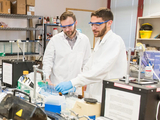Prof Blaney & partners publish landmark study on Chesapeake
This story was written by Megan Hanks and first appeared on news.umbc.edu
UMBC’s Lee Blaney and research partners have published a landmark study on contaminants of emerging concern in the Chesapeake Bay. Their article in Science of the Total Environment is the first research study that quantifies concentrations of antibiotics, estrogenic hormones, and UV-filters in multiple locations of the Bay.
Blaney, an associate professor of chemical, biochemical, and environmental engineering, conducted the research with Ke He, Ph.D ‘17, chemical engineering, and Ethan Hain ‘21, chemical engineering. They also partnered with collaborators at the U.S. Forest Service and the Maryland Department of Natural Resources.
Underway since 2016, their work highlights the importance of understanding how previously unexamined chemicals impact the environment. The project has been primarily funded by Maryland Sea Grant through a Program Development Fund to Blaney, and a Graduate Research Fellowship to Hain.
The researchers studied the prevalence of contaminants of emerging concern in water, sediment, and oyster tissue collected from the Eastern Shore of the Chesapeake Bay. Their study of how accumulated UV-filters negatively impact the environment is the first of its kind. UV-filters are one of the primary ingredients in personal care products, such as sunscreen and cosmetics. The accumulation of these UV-filters can impact organisms and animals.
Maintaining a healthy Chesapeake Bay
While the Chesapeake Bay is one of the most well-studied ecosystems in the United States, Blaney says that little is known about the sources, occurrence, and impacts of contaminants of emerging concern in this important estuary.
“As the health of the Chesapeake Bay continues to improve due to recent nutrient and sediment regulations, it is important to consider new threats from specialty chemicals like antibiotics, hormones, and UV-filters,” he explains. “The first step to ensuring the safety of the Chesapeake Bay is to measure the concentrations of these contaminants in water, sediment, and tissue.”
Lee Blaney. Photo by Marlayna Demond ’11 for UMBC.
The discharge of antibiotics into the Chesapeake Bay may speed up the spread and development of antibiotic resistance, a global public health challenge, explains Blaney. He adds that estrogenic hormones and UV-filters are considered priority chemicals of concern due to reported toxicity and other effects on reproductive systems in aquatic and marine organisms.
Over the past two years, Blaney and his team have continued to collect data throughout the Chesapeake Bay to better understand differences in contaminant levels. They have found relatively high levels of antibiotics in the Chesapeake Bay, and the reported concentrations are in the range that can select for antibiotic resistant bacteria. In addition, most samples have contained UV-filters, including two common in sunscreens that were recently banned from being sold in Hawaii due to concerns that they are toxic to corals.
The researchers argue that their findings suggest a need to improve municipal wastewater treatment and agricultural waste management to remove contaminants of emerging concern and prevent their introduction to the environment. In this regard, Blaney and his collaborators are actively working on a number of technologies to improve the transformation of contaminants into benign molecules that do not have antibiotic or estrogenic properties or other toxicity concerns.
Continuing to expand the research
In 2017, Blaney received a CAREER Award from the National Science Foundation to study contaminants of emerging concern and their effects on the urban environment. That research focused on the Gwynns Falls watershed in Baltimore, and the Chesapeake Bay research is an extension of that work. In addition to the public and ecological health concerns highlighted in the current article, Blaney also continues to examine issues like antimicrobial resistance and the impact of agricultural runoff.
Blaney was recently named associate director for sustainability engineering and liaison to the University System of Maryland (USM) vice chancellor for environmental sustainability. In this capacity, he will work closely with collaborators at the University of Maryland Center for Environmental Science and will lead additional sustainability-focused research projects within the USM.
Banner image: Lee Blaney, left, working with a student in the lab. Photo by Marlayna Demond ’11 for UMBC.
Posted: September 5, 2019, 10:32 PM
